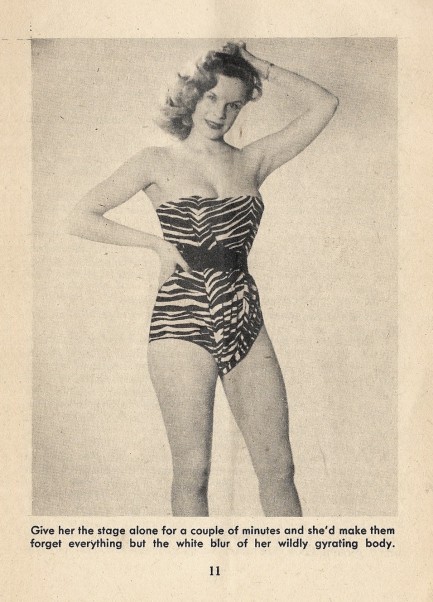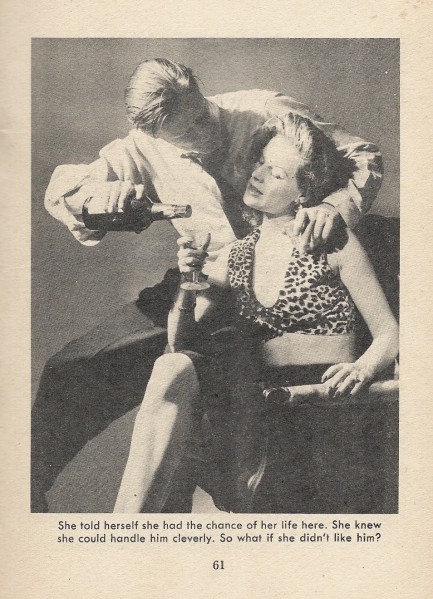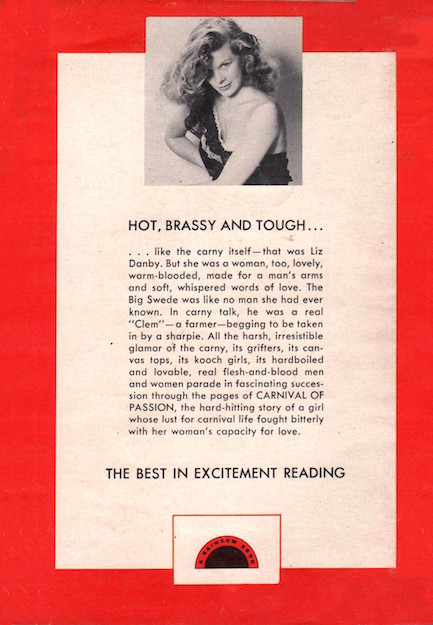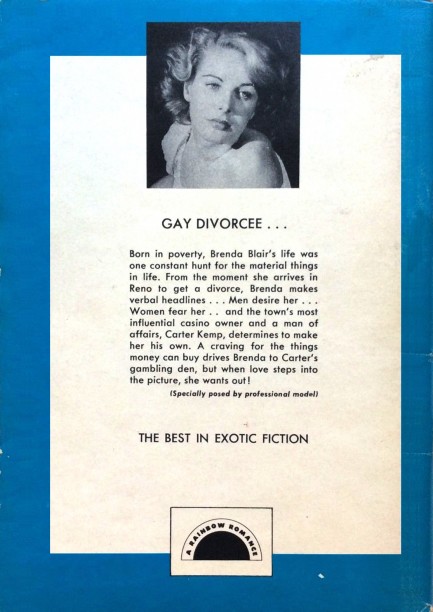 Hey there, stranger. You look like a man of impeccable taste and no small amount of disposable income. 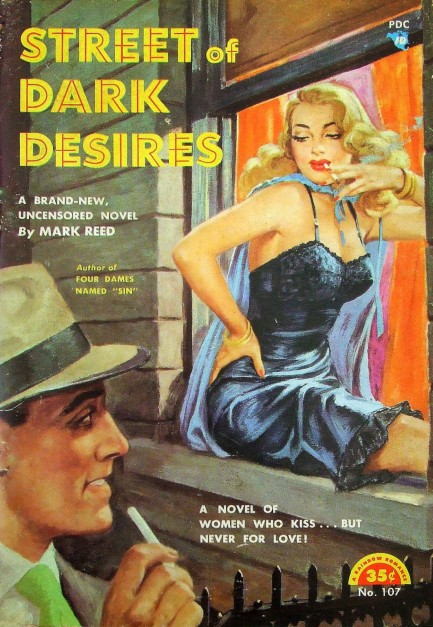
Above: a little sleaze to brighten your day, or maybe darken your night. Street of Dark Desires was written by Mark Reed and published in 1951 by Rainbow Books. We've read Reed, aka Norman A. Daniels, before. He was not special, but he often wrote for digest publishers like Rainbow that had brilliant cover art, like this effort by Howell Dodd, therefore his books are collectible, and sometimes expensive. We may try him again at some point.
 Dammit! First he goes after the sword swallower and now that contortionist. What do these women have that I don’t? 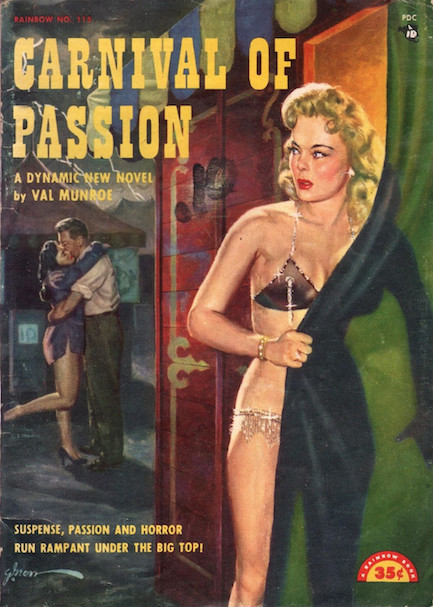
Years ago we wrote a two sentence blurb about Val Munroe's 1952 novel Carnival of Passion, with its excellent cover art by George Gross, but we never got around to reading it. What can we say? It got lost in the shuffle. But we finally cracked it open and decided to move that old post to today, delete what we wrote before, and share our many impressions. This is a first. We pride ourselves on our thirteen years of new content every day, which is why we initially resisted doing this. We'd already used the cover. But we read it anyway, and we're glad we did. There are many mid-century carnival novels. This one qualifies as ironic, because carnivals separated suckers from their money by any means necessary and rarely delivered as promised, while Carnival of Passion is the opposite—entertainment like this can only be considered a bargain.
The story centers on burlesque dancer Liz Danby—young, tough, beautiful, and carny to the core. When her swindler boyfriend cuts a vengeful townie and leaves her holding the bloody switchblade, she's forced to flee the pursuing sheriff while clad in only a g-string. Stranded in a rainstorm in nowheresville and starting from nothing, she manages to find clothes, a bus east, a Nebraska carnival town, and a new stripping job. Something else that's new is the hulking Swedish boxer Lars who she falls for in a big way. The two of them get together, sparks fly, and they plan to make a future together, but the violence and treachery of carny life presents obstacles, and of course there's that old boyfriend, also on the run, who'll never let Liz go. When he finally reappears it's in the midst of multiple subplots of clashing carny tension, and his presence is the spark that's liable to set the tinder ablaze.
Val Munroe, who was in reality an author named Frank Castle, will never be mistaken for a top talent, but his descriptive abilities are more than adequate to the task of detailing hard knock carny life, with its ballyhoos, hot kooch shows, and brutal cash boxing matches. He explains some terminology, but often doesn't bother, and just plows ahead concerning Clems and clems (upper and lower case), blow-offs, 10-in-1s, tips (not money), and more. But the real value of his writing is in the swiftness and conciseness of his story, and how effectively he portrays his protagonist Liz. You know what else is a real value? We were lucky enough to buy this back when it was cheap. We checked today and some joker is trying to sell it for $105. Talk about carnivals separating suckers from their money. It's a fun book, and it even has a couple of photos inside, but a hundred bucks? No. But if you happen to see it for twenty? Jump at it.
 Hi, what's a nice girl like you doing in a place like this? Me, I'm trying to score some meth. 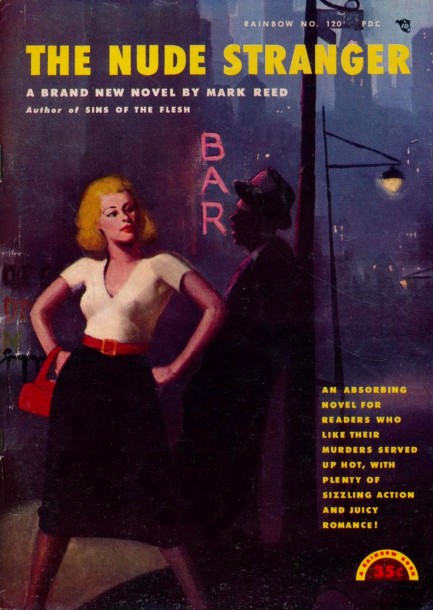
Mark Reed's 1952 thriller The Nude Stranger was going for eighty dollars on one website, but we got ours for five as part of a lot. Score. The book has a simple but effective cover painted by an uncredited artist. The story deals with the bizarre, complicated frame-up of a Florida private dick named Chet Egan, which commences when he finds a nude woman in his bed. He lives in a hotel, as people did back then, and she flees into his room from hers after trouble with a man, there to be discovered by Egan when he returns home. He gets the story from her, goes over to her room, takes care of the fella there with the old one-two, and has a corpse on his hands. And from there things go—as they always do—from confusing to confusingest, all written well enough, but unmemorable except for the labyrinthine nature of the central frame-up.
So what we have with The Nude Stranger is another so-so mystery, not a total waste of time, but nothing to go searching for either. And we'd be remiss if we didn't mention that it goes over the top with vicious homophobia. There are three gay males in the narrative, and they aren't referred to with anything other than an assortment of slurs except for one specific instance when Egan actually deigns to use one of their names. If you don't read a lot of old books it might surprise you to know that this level of disrespect is rare—not necessarily because the authors were enlightened on the subject, but because gay characters didn't feature much in vintage popular novels. The Nude Stranger, probably a completely forgotten book in the scheme of things, is notable in that respect. If you happen to be working on a thesis on homophobia in mid-century fiction, well, add this to your sources. You won't even believe it. 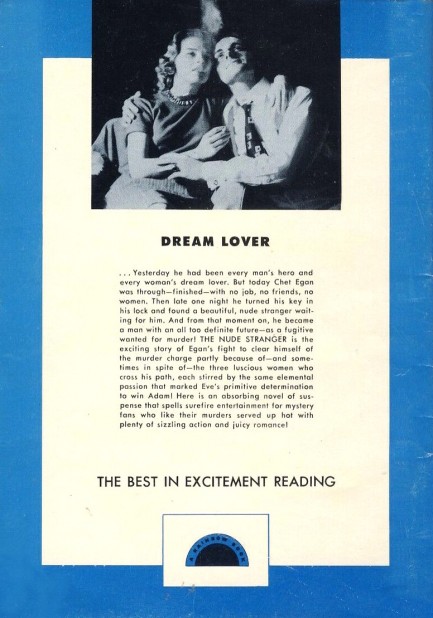
 So I thought to myself, why stop at my lips? I had plenty of lipstick and I was bored with this gold colored dress so I just kept going. 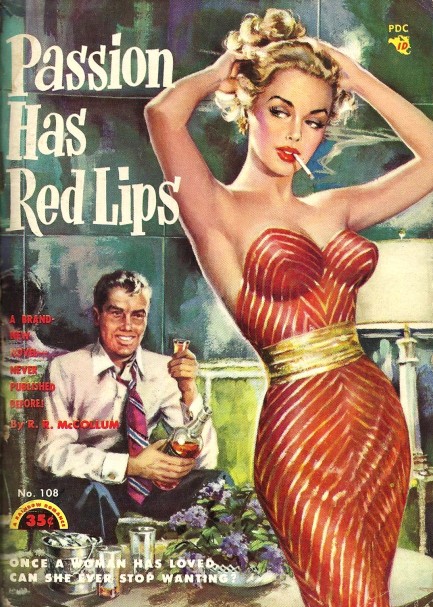 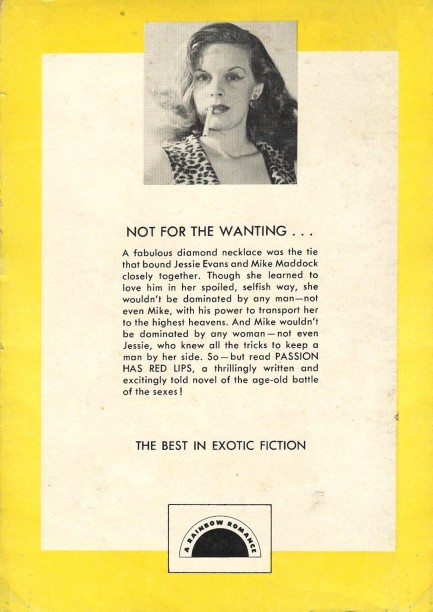
This is top quality George Gross art fronting R.R. McCollum's 1951 novel Passion Has Red Lips. You'll notice once again that trick of subtly phallic content in the art. Just look at the guy and the bottle he's holding that seems ready spill at any moment. This was published by Rainbow Books, a company renowned for its brilliant cover art. You can see more amazing examples by clicking its keywords below.
 Sorry about that. But since you caught me looking—in my opinion the black bustier and thong were much more flattering. 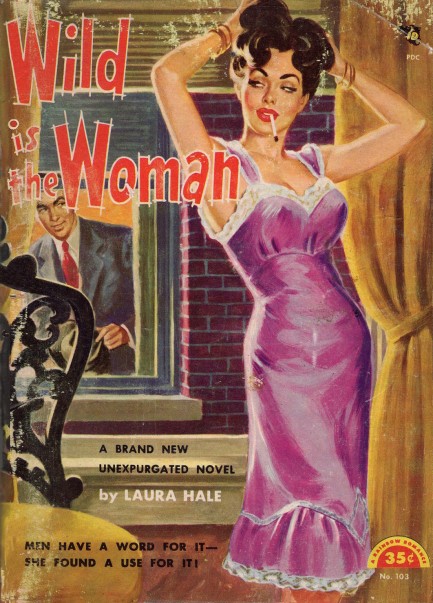
Writing as a woman wasn't uncommon for male sleaze authors, so it's no surprise 1951's Wild Is the Woman was written by a man inhabiting the pen name Laura Hale. The question is who was the man? Some sources say the author was Fredric Lorenz, but The Catalog of Copyright Entries—Third Series: 1951, which is old fashioned paper info scanned to an archive, says it was Lawrence Heller. They seem to be same person, with Lorenz serving as another pseudonym used by Heller. Now the question is who painted the cover? Unfortunately, nobody can say definitively, but we'd bet a lot of cash it's George Gross.
 So those four cards with A's on them mean you might win, right? 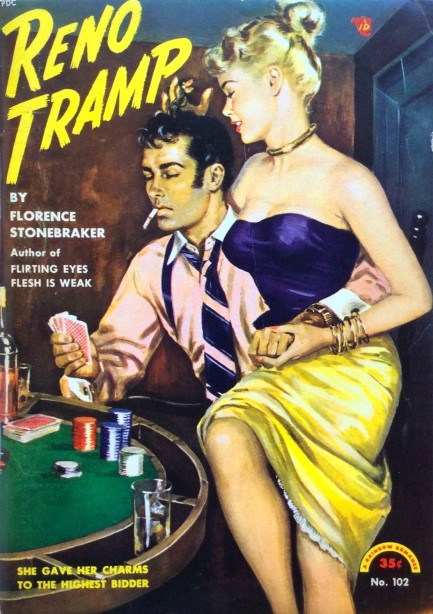
First published as an Ecstasy Novel with different art the previous year, this edition of Reno Tramp, appeared in 1951 on the Rainbow Books imprint with uncredited art. But the cover is by either Howell Dodd or Rudy Nappi, two artists whose work was similar, though we think Dodd tended to be a hair more precise—literally, as he expended more effort on his women's coiffures, in our opinion. In any case, the story in Reno Tramp deals with a girl from an impoverished childhood who arrives in Reno, Nevada as a beautiful young woman seeking a divorce, and whose need for money is a pathological drive. She finds just the rich pigeon she wants, but naturally another man comes along to complicate matters and make her question whether cash is really king. We'll keep an eye out for updated info and see if we can identify this cover artist down the line. In the meantime, you can see more from Dodd here, and Nappi here.
 Red-headed femme fatale looks mighty familiar. 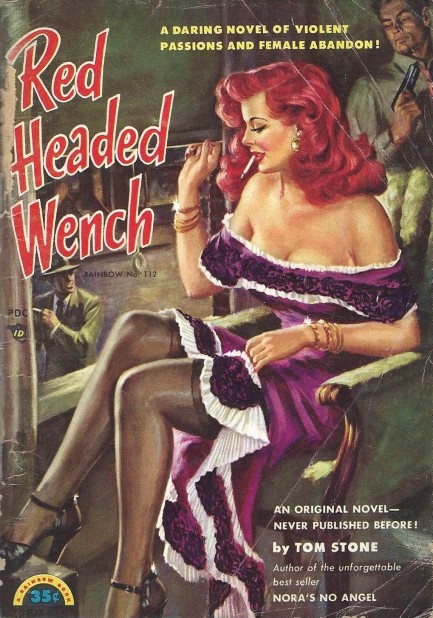
Gary Lovisi's guide to mid-century paperback cover art Dames, Dolls and Delinquents: A Collector's Guide to Sexy Pulp Fiction attributes this cover to George Gross but many online sources say it's the work of Howell Dodd. Though the internet is incredibly useful for replicating errors, we think the onliners are right this time. While the femme fatale here has some Gross-like elements to her, she has some Dodd traits too. For instance, Dodd's hair is a bit more sculptural than Gross's and his women's faces tend to be more severe. And speaking of faces, we think we know this one. Doesn't it belong to legendary red-headed actress Ann Sheridan? Yup, it's her—right down to the little bump in her classic nose. And he used her more than once, we think. A basically identical face appears in several other pieces of his. We're taking full credit for this discovery. Unless of course we're wrong, in which case we deny making any Sheridan related statements. Hey, if it works for presidential candidates it can work for us, right?
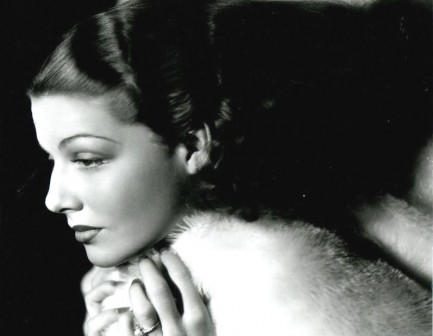
 It’s true I’m a little devil. But by morning you’ll say I made you see God. 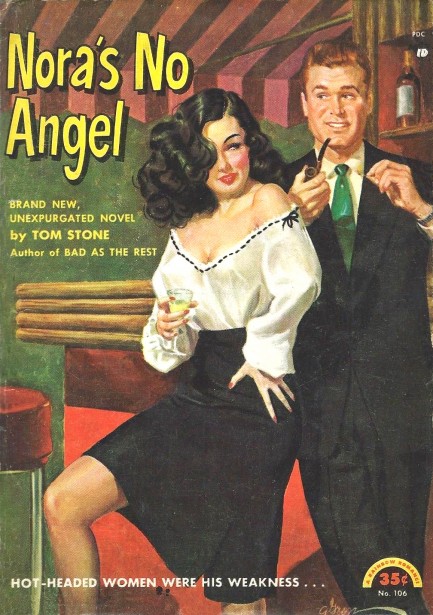
Above is a nice George Gross cover for Nora’s No Angel by Tom Stone, aka Florence Stonebraker, aka Ted Stratton. This came in digest format from Rainbow Books and you can see that Gross has his femme fatale dressed in the same style of off-the-shoulder drawstring blouse we pointed out before. We own the book, but our cover is a little jacked, so we borrowed one from online and touched it up a bit. Below, though, you see two interior pages we scanned (shots posed by models are common with these digests), plus the rear cover. We'll update this post when we get around to actually reading the book. It's 1951 copyright. Right, so we're writing in 2021 now, and here's your update. The surprise with this novel that took us years to finally read is that it's not the light sleaze you'd suspect, but a detective yarn starring a private dick named J. Gordon Ivers—Gordy to his pals. He takes a case for a rich woman who wants her son's tawdry affair broken up, but the girlfriend turns up dead and Ivers figures he needs to solve the murder in order to have an alibi. The Nora of the title doesn't appear until several chapters in, and indeed, the thrice divorced bombshell is no angel. This is a standard crime novel from Stonebraker, nothing special, but in branching away from sleazy romances she now seems like an author worth more exploration. We'll do that at the earliest opportunity.
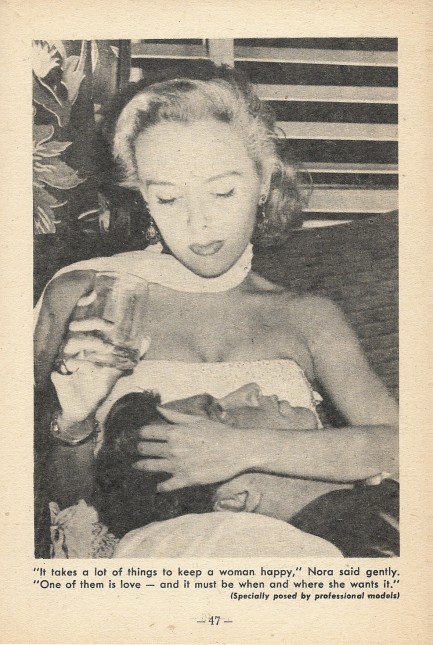 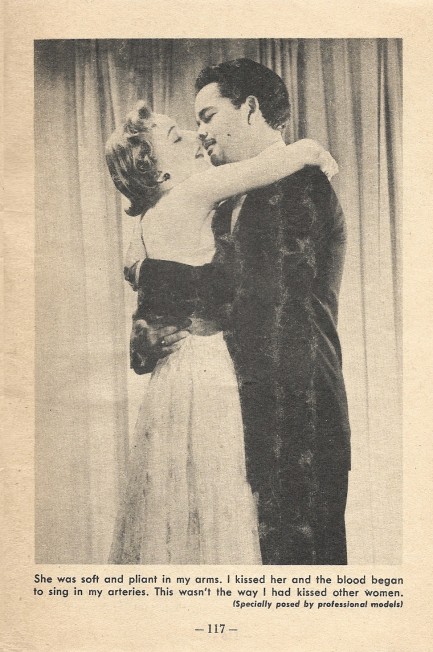 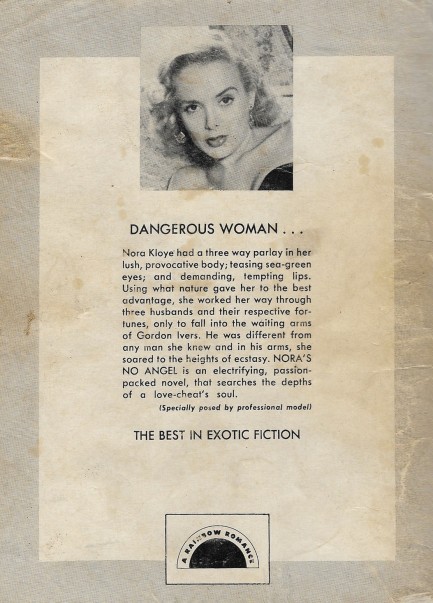
 Aw, don’t fret. Sure, you're corrupt, but you still protect a few people, and you’re about to serve me right now. 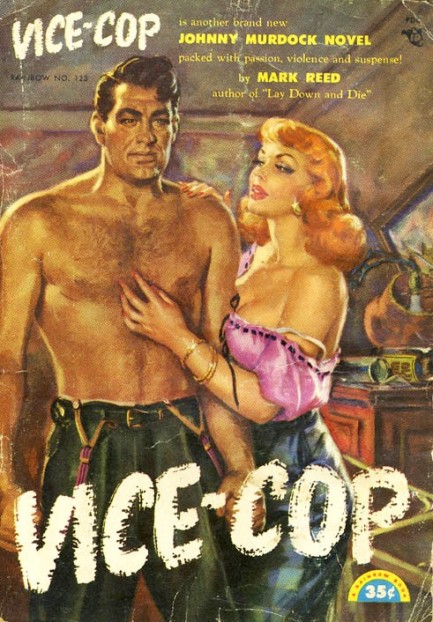
This excellent cover art for Vice Cop is uncredited but it’s very likely by Howell Dodd, he of the bombshell redheads. The art was reused in a slightly cleaned up version for a Phantom Books edition, and the two are worth comparing. Have a look here. Author Mark Reed was aka Norman A. Daniels. We’ll get back to him.
 They got on like a hayloft afire—until the barn burned down. 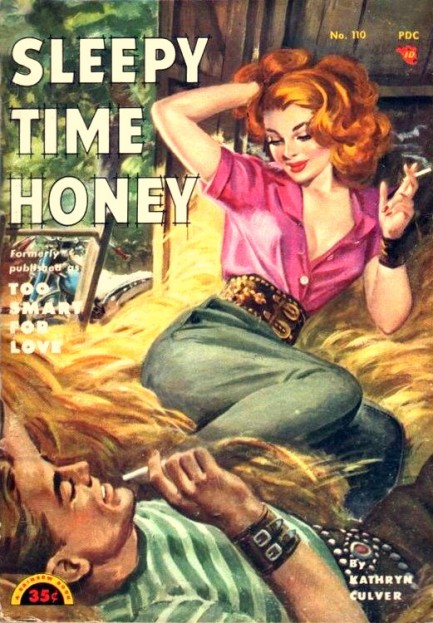
In pulp, people are careless with cigarettes, as we’ve pointed out before, and above is another example. Originally published in 1937 as Too Smart for Love, Rainbow Books came out with this digest paperback in 1951. The set-up here is simple—bad girl Janet Stang pursues men for their money. Author Kathryn Culver was in reality the prolific Davis Dresser, who also wrote as Brett Halliday, Don Davis, Asa Baker, Matthew Blood, Don Davis, Hal Debrett, et.al. The art here is by Howell Dodd and it’s top quality work, in our opinion. Dodd had a thing about redheads and made them a staple of his work, so we’re going to gather up a collection of these women and show you more later.

|
 |

The headlines that mattered yesteryear.
1986—Otto Preminger Dies
Austro–Hungarian film director Otto Preminger, who directed such eternal classics as Laura, Anatomy of a Murder, Carmen Jones, The Man with the Golden Arm, and Stalag 17, and for his efforts earned a star on Hollywood's Walk of Fame, dies in New York City, aged 80, from cancer and Alzheimer's disease. 1998—James Earl Ray Dies
The convicted assassin of American civil rights leader Martin Luther King, Jr., petty criminal James Earl Ray, dies in prison of hepatitis aged 70, protesting his innocence as he had for decades. Members of the King family who supported Ray's fight to clear his name believed the U.S. Government had been involved in Dr. King's killing, but with Ray's death such questions became moot. 1912—Pravda Is Founded
The newspaper Pravda, or Truth, known as the voice of the Communist Party of the Soviet Union, begins publication in Saint Petersburg. It is one of the country's leading newspapers until 1991, when it is closed down by decree of then-President Boris Yeltsin. A number of other Pravdas appear afterward, including an internet site and a tabloid. 1983—Hitler's Diaries Found
The German magazine Der Stern claims that Adolf Hitler's diaries had been found in wreckage in East Germany. The magazine had paid 10 million German marks for the sixty small books, plus a volume about Rudolf Hess's flight to the United Kingdom, covering the period from 1932 to 1945. But the diaries are subsequently revealed to be fakes written by Konrad Kujau, a notorious Stuttgart forger. Both he and Stern journalist Gerd Heidemann go to trial in 1985 and are each sentenced to 42 months in prison. 1918—The Red Baron Is Shot Down
German WWI fighter ace Manfred von Richthofen, better known as The Red Baron, sustains a fatal wound while flying over Vaux sur Somme in France. Von Richthofen, shot through the heart, manages a hasty emergency landing before dying in the cockpit of his plane. His last word, according to one witness, is "Kaputt." The Red Baron was the most successful flying ace during the war, having shot down at least 80 enemy airplanes. 1964—Satellite Spreads Radioactivity
An American-made Transit satellite, which had been designed to track submarines, fails to reach orbit after launch and disperses its highly radioactive two pound plutonium power source over a wide area as it breaks up re-entering the atmosphere.
|

|
|

It's easy. We have an uploader that makes it a snap. Use it to submit your art, text, header, and subhead. Your post can be funny, serious, or anything in between, as long as it's vintage pulp. You'll get a byline and experience the fleeting pride of free authorship. We'll edit your post for typos, but the rest is up to you. Click here to give us your best shot.

|
|




